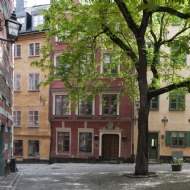Urbanisation and population growth drive 57% rise in European residential investment
30 March 2016
Over €40.7 billion was invested in residential accommodation across Europe in 2015 – a 57% increase on volumes in 2014 – as population growth and urbanisation in key cities across the continent has led to a boom in demand says Savills.
The rising trend of urbanism, which will concentrate 80% of Europe’s population in urban areas by 2050, is already putting pressure on the fastest growing cities, with London, Paris, Amsterdam, Madrid, Stockholm and some German cities all projected to experience significant population growth. Savills Spotlight on Alternative Assets report states that these locations have thus seen the emergence of the multi-family and apartment sectors as destinations for institutional capital, supported by political initiatives and regulations in some countries, however there are significant variations in dynamics between markets.
See a chart showing the rise in investment in European apartments here.
Eri Mitsostergiou, Director, Savills European research, says:
“Since the financial crisis, whether through necessity or choice, renting has grown to rival home ownership even in European countries which traditionally prize owner-occupation. Investment into apartment or multi-family property has correspondingly grown in size and importance as an alternative investment to commercial real estate, supported by the imbalance of demand and supply of homes in the expanding conurbations of Europe and the positive rental growth potential.”
United Kingdom
Institutional investment in the UK rental market has grown steadily over the past five years, and the continued mismatch between supply and demand for rental homes is likely to underpin further rent rises, particularly in undersupplied markets, representing a further opportunity for institutional investment. Some big domestic and international players have entered the rental market and the flow of capital is building up. The overall value of deals recorded by Savills own investment database has increased from £2.3bn in 2014 to £2.65bn in 2015 - 60% of this is captured by London. The number of deals backed by institutions doubled between 2014 and 2015.
Germany
Germany continues to dominate the international residential investment market in Europe. Last year volumes rose by two thirds on 2014 to almost €22.5bn. The strongest increase of volume was in second tier cities (beyond the big seven), with German investors, which ate largely residential property companies, accounting for 90% of the transaction volumes. Favourable market conditions are expected to continue to drive activity, with current completion figures far below the 350,000 to 400,000 units required per year to meet future demand, with the overall vacancy rate currently below 3%.
The Netherlands
Residential investment in The Netherlands increased by €2.85bn in 2015, accounting for over a quarter of total commercial real estate investment volumes. Traditionally the sector has been dominated by private and institutional domestic investors, however, recent changes in the legislation impacting the social housing market, in combination with more favourable financing conditions, has fuelled international demand for residential portfolios over the last two years. Although demand and supply is gradually becoming more balanced, in the mid- to long-term the changing demographic trends and the rising number of households in urban areas, particularly in and around Amsterdam, could fuel investment in new developments and refurbishments. Currently it is estimated that there is a deficit of 4-5% of the current stock nationwide, which translates to about 300,000 to 400,000 dwellings.
Nordics
In Sweden the residential sector accounted for almost a quarter of the total investment in real estate in 2015. Since the financial crisis, Swedish institutions and pension funds have invested heavily into the residential segment with the total increase in holdings of residential assets amounting to at least SEK 75bn (€8.01 billion) since 2008. The ongoing need for more housing – estimated to be over 460,000 new homes by 2020 and up to 700,000 in ten years – points to a future of continued opportunities for investors.
The residential sector dominated non-commercial investments in Finland in 2015 with the investment volume total of €1.24bn in 2015 representing a 23% share of all transactions. With the launch of several residential funds since 2013, investments in residential portfolios have taken more significant exposure. In addition, driven by the expansion of the build-to-rent model, major developers have boosted development activity. Residential has been the best performing sector for seven consecutive years thanks to high occupancy rates and continuing rent increases. The average total return for residential investments in past five years is 9.3%, split into income return of 5.5% and capital growth of 3.6%. Value growth in the Helsinki market has outperformed other locations.
Spain
The Spanish residential sector showed signs of a solid recovery in 2015 after eight years of collapse. Price corrections up to 40% from peak values, coupled with favourable financing conditions, are signalling the start of a new cycle, with the market becoming more institutionalised as investor interest rises. The institutional investment market has been dominated by UK and US funds, focused both on social housing and multi-family assets. Lonestar led the market recovery early in 2015, when it acquired Neinor Homes and over a hundred plots of land to develop residential on over the next four years. The increasing demand for rental property has increased the rental share of the market from 11.5% to 19.2% over the last 10 years and is predicted to continue. Despite low yields at 3-4%, further capital gains are expected in the mid-term.
Ireland
Apart from several isolated schemes, multi-family did not exist as a separate asset class in Ireland before 2012. However, during the economic crisis when many unoccupied apartment schemes became available, early investors spotted the opportunity to buy developments at very attractive yields. Multi-family thereby rose to account for over 12% of total investment in 2012 and 2013. Over the last four years nearly €1bn has been spent on multi-family assets in Ireland with almost 6,000 units sold. 95% of these were in Dublin, meaning that 11.5% of all residential units sold in the Irish capital from 2012-2015 were traded in multi-family blocks. The sector is now transitioning to a design-build-operate model and, within this, some developer-investors are likely to move towards specialist niches such as student housing and seniors housing.
Download Savills Spotlight on Alternative Assets report here.
General Enquiries
+44 (0) 20 7075 2827
Key Contacts

Editorial Content and Senior PR Manager, Director
Cross Border B2B Communications
Head Office London
+44 (0) 20 7075 2827

